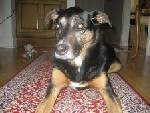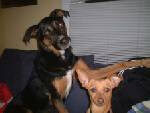 Sam is a 10-year-old Doberman mix, who presented on emergency one night with a sudden onset of retching accompanied by a distended and painful abdomen. Abdominal x-rays confirmed our initial suspicion: Sam was suffering from a potentially fatal condition called gastric dilatation-volvulus (GDV). To help prepare Sam for surgery, we immediately started him on intravenous fluids and pain medication.
Sam is a 10-year-old Doberman mix, who presented on emergency one night with a sudden onset of retching accompanied by a distended and painful abdomen. Abdominal x-rays confirmed our initial suspicion: Sam was suffering from a potentially fatal condition called gastric dilatation-volvulus (GDV). To help prepare Sam for surgery, we immediately started him on intravenous fluids and pain medication.More commonly known as “bloat,” GDV occurs primarily in large breed, deep-chested dogs such as Great Danes, standard poodles, Doberman pinschers, boxers and German shepherds. For reasons that remain unknown, the dog’s stomach fills with air and rotates, restricting blood flow to and from the abdomen. This lack of blood flow can quickly lead to shock, resulting in tissue death of abdominal organs. In addition, when the heart is deprived of blood, it cannot pump as effectively, and the heart muscle begins to die, causing cardiac arrhythmias.
When I opened Sam’s abdomen his stomach was severely distended and twisted. My first step was to check the condition of the stomach tissue, to see if it had started to die which would require resection. Sam was lucky: his stomach tissue still appeared healthy. I quickly reached in and de-rotated the stomach back into its appropriate position.
Next, I assessed Sam’s spleen. Since it is closely attached to the stomach, the spleen can rotate along with stomach and often must be removed. Once again, luck was on our side: while initially Sam’s spleen was enlarged and an angry purple color, it returned to a normal size and color just a few minutes after his stomach was repositioned. Sam’s other abdominal organs were healthy in appearance.
After correcting the positioning of the stomach and emptying it of all the trapped gas and fluid, I performed a gastropexy. This procedure literally attaches the stomach to the body wall within the abdomen and thus prevents the stomach from twisting. After surgery Sam was started on a constant rate infusion of pain medication and was hooked up to an ECG so we could monitor him for any cardiac arrhythmias. Sam recovered quickly from surgery and was sent home two days later to his very happy owners.
Anyone with a large-breed dog should be aware of GDV and watch their dog carefully for non-productive retching and abdominal distension. These signs can also be accompanied by hyper-salivation, restlessness, inability to stand and depression. A GDV or bloat is one of the few true surgical emergencies. It is essential to get treatment for your dog as quickly as possible is essential. Lucky for Sam, his owners knew what to look for and acted immediately.
 This is Sam with his buddy Murray who was also very relieved to have him home.
This is Sam with his buddy Murray who was also very relieved to have him home.








Are there any preventaive measures that can be taken?
ReplyDeleteA gastropexy can be performed as a preventative measure. At Friendship we usually recommend that this be done in large breed, deep-chested dogs at the time of the spay or neuter surgery.
ReplyDelete